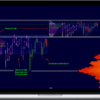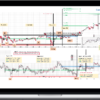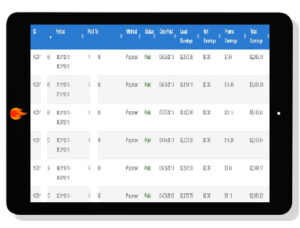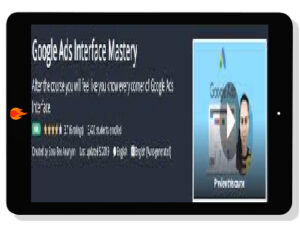Wyck Analytics – Basic Charting Course
This course presents a wealth of foundational chart-reading knowledge, encompassing both Technical Analysis (TA) and the Wyck Method. You will learn elemental to intermediate charting principles, including our personal interpretations of conventional (TA) concepts within a Wyck Method context. The Basic Course focuses on the essential analytical techniques that will allow you to make a seamless transition from TA to the Wyck Method!
What You’ll Learn In Basic Charting Course?
Types of Charts: Vertical (aka Bar), Candlestick, Point & Figure (P&F), Candlevolume
Descriptions and visual explanations of each type, including appropriate usage contexts and benefits
Vertical bar (+ volume bars) – Tape Reading
Point-and-Figure – companion to vertical charts, horizontal counts, less price volatility (not time), tape reading, volume
Candlestick – Basic structure + visualizations
Candlevolume charts – Combining candlestick + volume
Time Frames: intraday, daily, weekly, monthly
Traditional timeframes and how they are best used. Campaigns (weekly + monthly), swing (daily), intraday (intraday + daily)
Combining multiple timeframes
Price and volume patterns are fractal on different time frames
The Market as a Discounting Mechanism and a visual representation of campaigns actions conducted by the Composite Operator (CO)
Technical Analysis reveals the Discounting Mechanism. Definition. Long-term trend initiation, with catalyst(s) appearing later on.
The Composite Operator as a heuristic for institutional participation
Cyclicality vs the Price Cycle
Technical Analysis Cyclicality. 3-5 year business cycle
Business cycle corresponds with the market cycle
Wyck Price Cycle: Accumulation, Mark-up, Distribution, Mark-down
Trends and trading ranges within Price Cycle
Price Cycle sequence: Accumulation, Mark-up, Re-accumulation, Mark-up, Distribution, Mark-down, Re-distribution
Cyclicality of Price inside the channel
Different time frames’ cyclicality and the Price Cycle
Trading Range: Support/Resistance, Breakouts, Failed Breakouts, Upthrusts (UT) and Springs/Shakeouts(SO) or Signs of Strength (SOS)/Signs of Weakness(SOW)
Technical Analysis: Trading ranges explained
Technical Analysis: Support and resistance defined
Technical Analysis: Breakouts and failed breakouts
Wyck: Support and resistance defined
Wyck: UT and Spring/SO as failed breakouts + SOS/SOW as successful breakouts
Trends: Definition – Higher Highs(HH)/Higher Lows (HL). Logarithmic vs arithmetic scales. Moving averages (MA), Linear Regression Line (LRL)
Technical Analysis: Trend Definition. HH/HL for uptrends and the reverse for downtrends
Comparison of logarithmic vs arithmetic scaling
Technical Analysis: Trend defined by TA tools (MA, Linear Regression Line)
Wyck: Also HH/HL
Trends: Conventional and Reverse Trendlines. Break of trendlines/Change of Character (ChoCh)
Throw-overs and Oversold/Overbought conditions
Break of Trendline signal. TA vs Wyck CHoCH
Visuals: Multiple examples
Price formations: Technical Analysis Patterns
Reversal vs continuation patterns
Trading ranges, including triangles, flags and pennants, wedges
Triangles of different kinds compared with Wyck’s Hinge or Apex
Head & Shoulders, inverse patterns, double tops and bottoms,
Parabolic, V-formations or spikes
Rounding top/bottom formations
Wyck Price Formations: Accumulation
Accumulation Events: Selling climaxes, secondary tests, springs, and others
Accumulation Phases. Predictable sequences of Accumulation events
Wyck Price Formations: Distribution
Distribution Events. Buying climaxes, secondary tests, UTs, and others
Distribution Phases. Predictable sequences of Distribution events
Basic Technical Analysis definitions
Volume leads price.
Volume confirmation of price, with examples. Volume as evidence of Demand or Supply (or both).
Volume divergence from price (non-confirmation), with examples.
Wyck Laws: Supply and Demand
Wyck’s Law of Supply and Demand drives the Price Cycle. Example: Exhaustion of Supply in a trading range leads to an uptrend.
Case study: Price Cycle resulting from changes in Supply and Demand
Wyck Laws: Effort vs. Result
Effort vs. Results law. Definition.
Result in line with Effort
Non-confirmation. Result not in line with Effort.
Wyck Comparative analysis
Original Wyck Course comparative visuals
Basic construction and interpretation
Significant highs and lows + slope
Issues with comparative analysis
Relative Strength (RS) analysis
Definition and basic construction
Basic interpretation
Heat Map ranking based on changes in RS
Technical Analysis Indicators useful to Wyck Traders. Rate of Change (ROC), Relative Strength Index, Stochastics, and On Balance Volume (OBV)
Volume: OBV
Momentum: ROC
Basic Technical Analysis P&F concepts (vertical measurements)
One of the oldest charting methods
P&F breakout patterns
Vertical price objectives
Wyck P&F Basics (horizontal counts)
Wyck’s Law of Cause and Effect
Basic horizontal counting guidelines to determine price targets
1-box (swing) vs 3-box reversal (campaign)
Intraday P&F counts examples







